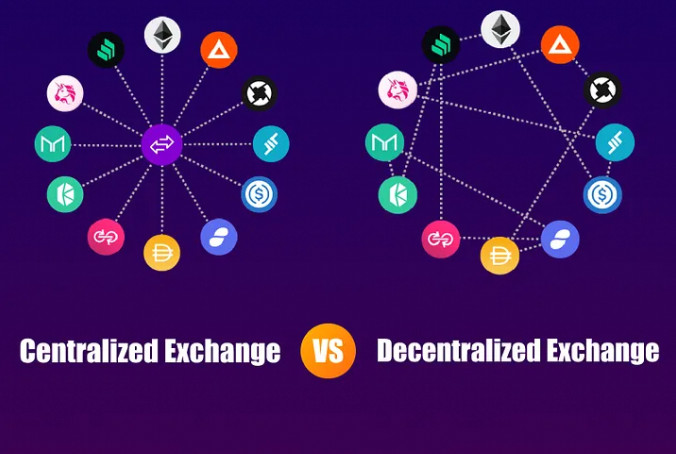
Crypto Exchange Platform models are no longer just centralized gateways for trading digital assets—they’re rapidly evolving into hybrid ecosystems blending efficiency, transparency, and user control. In July 2025, the cryptocurrency market crossed the $4 trillion valuation mark, driven by institutional adoption and new regulatory clarity. As Reuters reports, this milestone “reflects its transformation into a core component of global finance”.
But amid this growth, centralized exchanges (CEXs)—once unchallenged—are losing momentum. In Q2 2025, the volume of spot trading on CEX plummeted more than 28 percent to 3.9 trillion. Meanwhile, decentralized exchanges (DEXs) have surged, reaching a high of $876.3 billion in spot volumes and an unprecedented ratio of DEX to CEX of 0.23.
This shift is an indication of the emergence of hybrid models- platforms that combine both centralized liquidity and speed with decentralized custody and transparency.

Since the inception of Bitcoin, centralized exchange platforms such as Binance, Coinbase, and MEXC have primarily dominated in terms of affordability, liquidity, and fiat gateways. Binance ranked almost first in the world in July 2025 with about 40 percent of the social exchange collected, followed by MEXC with 8.6 percent and Gate at 7.8 percent.
However, this hegemony came at a cost; constant hacks, murky reserve model, and infamous FTX collapse in 2022 killed investor confidence. Traders began demanding models where trust is earned through transparency, not promises.
Decentralized exchanges such as Uniswap and PancakeSwap provided that trust by enabling peer-to-peer trades directly from wallets. With censorship resistance and self-custody, DEXs picked up a new crowd of privacy-minded and security-focused users.
However, they had their share of drawbacks: steep entry barriers, incredibly volatile liquidity, and just minimal amounts of compliance. For mass adoption, investors needed something in between.
Hybrid platforms fill this gap. They integrate ordered books, liquidity depth, and the custodial and governance advantages of decentralized design.
The model enables a retail user experience with intuitive trading paired with institutional regulatory-grade compliance and non-disclosure, and auditability of reserves. We can say that, by using hybrids, it is possible to make crypto exchanges efficient and trusted at the same time.
The failure of FTX restructured the mentalities of users/traders by demanding verifiable solvency and more control over their money. By using on-chain proof-of-reserves and optional non-custodial trading wallets, the hybrid platforms restore confidence without relinquishing liquidity.
A survey by Glassnode in 2025 revealed that 62 percent of investors now want to use exchanges that have integrated self-custody solutions, and this illustrates how user demand is shifting to hybrid solutions.
CoinGecko’s Q2 2025 report highlights DEXs growing 25.3% quarter-on-quarter, compared to a 27.7% decline in CEX volume. PancakeSwap alone expanded trading activity by 539% thanks to hybrid routing linked to Binance Alpha.

This isn’t a passing trend—it’s evidence that platforms offering hybrid architectures outperform those locked in legacy models.
Institutions are no longer sidelined in crypto—they now drive much of the volume. But they demand compliance, stability, and risk management tools. Pure DEXs can’t offer that, while traditional CEXs sometimes fail transparency tests.
Hybrid exchanges meet in the middle: integrating KYC/AML compliance, institutional custody solutions, and governance tokens that let communities shape decision-making.
A successful hybrid Crypto Exchange Platform must check several boxes:
By combining these characteristics, the exchanges will be able to please not only regulators but also retail traders and institutions.
Within the next five years, hybrid platforms may completely reshape how people trade crypto. Innovations already on the horizon include:
These innovations will result in hybrid exchanges becoming the industry standard rather than an option.
The world of crypto trading is really at a turning point. You know what? Centralized exchanges have opened the doors for millions to access multiple digital assets, which provide liquidity and a perfect way for institutional investors to jump in. However, a series of hacks, custodial risks, and a lack of transparency are still there. On the other hand, if we talk about decentralized platforms, they are working pretty good and providing a trading experience without trust issues. They are providing more control for users. But still have to work on their scalability, fragmented liquidity, and regulatory compliance.
This persistent battle has given way to the emergence of the hybrid Crypto Exchange Platforms, a combination of the two worlds. Hybrid exchanges are finding a middle ground that lets users choose to self-custody, use the centralized liquidity pools, and also adhere to compliance requirements to keep regulators a happy bunch, without losing the core property; decentralization.
This is not a change only in technology but really around the rebuilding of trust, which has now become the most valuable asset in the crypto world as 2025 approaches. Investors are now on the lookout for security, efficiency, and transparency all in one package, and only the platforms that can deliver on these expectations will survive.
The pressure is intense with a market capitalization of more than 4 trillion dollars. The hybrid exchanges are not simply a trend; instead, they are the new foundation of the post-pandemic age in digital finance. In the next several years, platforms that combine the focus on innovation with being sensitive to user needs and regulatory requirements will not only succeed but also become the key to the future of finance.
The post How Centralized Exchanges Are Evolving: The Shift Towards Hybrid and Decentralized Platforms appeared first on Metaverse Post.
Also read: Zypher Network Airdrop: Binance Alpha Lists POP on Sep 10